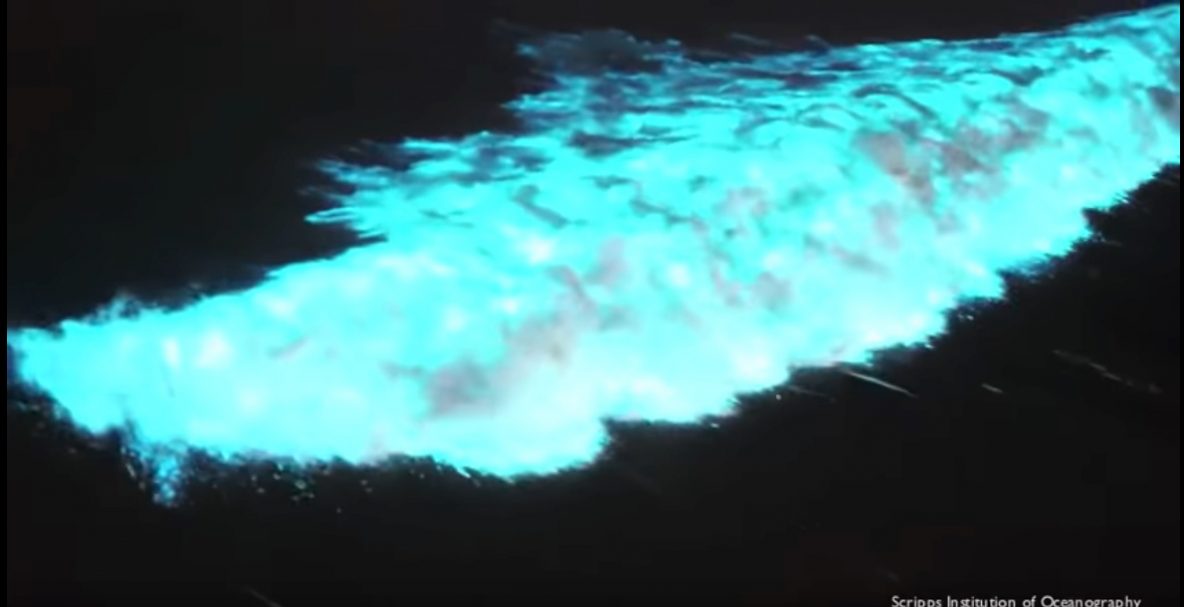This comprehensive review paper of mechanically stimulated bioluminescence of plankton such as dinoflagellates and zooplankton is a good source of information of their flash emissions. It summarizes the results of hundreds of articles and provides a good background for those interested in plankton bioluminescence. https://www.frontiersin.org/articles/10.3389/fmars.2023.1299602/full Here is the abstract: Bioluminescence is ubiquitous in marine ecosystems and found in uni- and … Read More
Are Microorganisms Real?
This entertaining video was made by students in the professional master’s program at Scripps Oceanography: https://m.youtube.com/watch?v=mC-aYQdGNhc To answer the question, yes microorganisms are fundamentally important components of all ecosystems, including our own bodies. We live in a microbial world!
Sep 21, 2023: Glowing Worms in Mission Bay, San Diego
The fireworm Odontosyllis phosphororea is a local polychaete worm that inhabits the bays of San Diego. They normally live in parchment tubes that are attached to hard surfaces. But every summer within a few days of the quarter moon, these tiny worms emerge and present a spectacular display of mating while emitting a bright blue-green light. The females come first … Read More
New Animated Film on Bioluminescence
A new animated film, “A Sea of Lights“, was created and produced by Alisa Kazarnovsky for her undergraduate thesis at The Cleveland Institute of Art. “A Sea of Lights” is an immersive journey capturing the beauty and science of bioluminescence, while following various marine organisms to gain a better understanding of how they use their light in the ocean darkness. … Read More
Soft Robotic Applications Using Dinoflagellate Bioluminescence
A collaboration with Prof. Shengqiang Cai in the Department of Mechanical and Aerospace Engineering at UCSD has led to the development of soft devices containing bioluminescent dinoflagellates that glow in the dark when experiencing mechanical stress, such as being squished, stretched, twisted or bent. The devices do not require any electronics to light up, making them an ideal choice for building … Read More
‘Lightschool’ at California Academy of Sciences
As part of the Nightschool video series at the California Academy of Sciences, their Lightschool program featured in part artist Iyvone Khoo, co-creator of the bioluminescence art installation Infinity Cube. In a multimedia presentation, Iyvone discusses her artistic journey working with bioluminescence. For more information about the science of Infinity Cube, download this article by Dr. Latz.
The Terrifying (but Awesome) Science Behind Red Tides [and Bioluminescence]
In this 2020 production by the American Chemical Society, PBS, and YouTube, learn about red tides and bioluminescence. Complex concepts about light, photosynthesis, toxins, and bioluminescence are explained in a simple manner. “Maybe you already knew that deadly algal tides discolor ocean waves, deplete the water of oxygen, and release toxins that can kill a huge range of ocean critters, … Read More
It’s a Bioluminescent Red Tide!
April 29, 2020: We are experiencing a red tide, a massive bloom of the dinoflagellate Lingulodinium polyedra, which is a common member of the local plankton community. Sometimes it gets so abundant that it discolors the water reddish/brown, hence the name red tide. And this is big one, stretching from Baja California to Los Angeles. It was first detected at a … Read More
Article about Infinity Cube, a Bioluminescence Art Exhibit
In this article, published in the November 2019 issue of Limnology and Oceanography Bulletin, Dr. Latz recounts the making of Infinity Cube, a bioluminescence art exhibit that was displayed at the Birch Aquarium of Scripps Institution of Oceanography during 2017-2018. In collaboration with London-based artist Iyvone Khoo, Infinity Cube consisted of a dark ‘sensorial space’ of video projection and sound within a … Read More
Why is the Iconic Bioluminescent Dinoflagellate Noctiluca not Bioluminescent along the West Coast of the USA?
The dinoflagellate Noctiluca scintillans was described as ‘animalcules’ in the 1750’s using early microscopes and is now known as a major source of bioluminescence in the world’s oceans. But reports going back to the 1960’s describe non-bioluminescent Noctiluca along the west coast of the USA. In this study, published in the November 2019 issue of Limnology and Oceanography, an international … Read More

